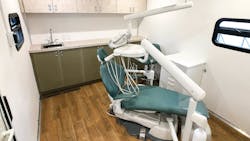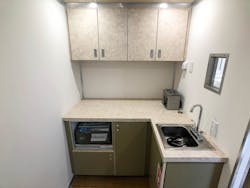Two roads diverged in a yellow wood ... I took the one less traveled by, and that has made all the difference. — Robert Frost
Said differently than Mr. Frost’s quote, observe the masses and then do the opposite. The majority of dentists practice their full career in a particular setting, whether it’s a private practice, academics, or the military, and then either transition out completely or into another traditional path, such as temping, volunteering, or teaching. All these options are viable and many lead to continued usefulness and engagement in dentistry. However, there is a different way of doing things.
Consider taking your skills and using them to open a new world of access to those who need it most. Elderly patients, children in schools, and employees in corporate or manufacturing facilities all need dental care, and many cannot fit it into their schedules, or they must depend on others to make their appointments and provide transportation. Others simply have no access to the care unless someone brings the care to them. Mobile dentistry provides the answer to these issues and can be a very rewarding way to continue using your lifetime of skills.
In my experience after dental school, I had a four-year term in a large teaching hospital in the US Air Force, where I received training in all dental specialties, including operating room and anesthesia. I then transitioned to a traditional brick-and-mortar practice where I used those skills to provide comprehensive complex restorative and cosmetic dentistry with a health-centered approach employing the Pankey and Dawson philosophies.
While that practice modality was both intellectually challenging and financially rewarding, after several circumstances occurred, I learned of an unmet need among economically disadvantaged children. So, I started an experiment to determine if I could meet those needs. What began as an altruistic outreach experiment turned into two very viable businesses: a mobile dental practice, Dental Access Carolina, that goes to schools to treat economically disadvantaged children, and a mobile dental clinic design and manufacturing company, Dental Access Mobile Clinics, that fabricates clinics designed by dentists for dentists. Both fill needs that were not being met previously by the existing frameworks. To dispel the myth that this type of thing can’t be done or that it takes years to accomplish, I transitioned from full-time practice in a traditional brick-and-mortar setting to practicing full time in a mobile clinic setting during the school year in less than six months.
Unlike my story, when many hear the term “practice transition,” they picture a change at retirement age, leading to the doctor leaving dentistry entirely or drastically reducing the time spent practicing. While that scenario constitutes most practice transitions, the number of transitions in early or mid-career are becoming more common, largely due to the number of practices being sold to dental service organizations or corporations. The reasons for these early sales are many, but the most common is that a sale can be guaranteed and allows the doctor to continue practicing. This contrasts with taking the chance on bringing in an associate or partner in hopes of a buy-out or simply taking a chance on an outright sale at the end of a career.
More by Dr. John Reese
Mobile dentistry: Do well by doing good
Mobile dentistry done right
Just as with a sale to a DSO, a transition to mobile dentistry can be done at any time during a doctor’s career. It can be either a complete shift, as I did, or an addition to a traditional practice mode to increase the practice’s geographic reach and patient base without having to build a new office. Our mobile clinic customers have used the clinics to expand the reach of orthodontic practices, provide services to patients at elder care facilities and in-patient behavioral health facilities, visit manufacturing facilities and large corporate offices, and for humanitarian outreach projects both here and abroad. Additionally, several governments have purchased our clinics to treat the needs of their citizens.
For doctors who are ready to leave the traditional model completely or who are looking to fulfill an altruistic spirit, the mobile setting can be for humanitarian efforts either at home or abroad. Using a properly designed and equipped mobile clinic affords the dental team the ability to practice the same types of dentistry they did in their usual setting without having to compromise or severely limit the procedure mix. Having the ability to practice in a consistent and controlled environment is very rare in most outreach efforts. The lack of a proper clinical environment leads to frustration and reduced effectiveness of the outreach effort, and unsatisfied volunteers. This professional dissatisfaction creates a lack of consistency in the program due to a revolving door of volunteers and leads to failure of the operation, which hurts the ones who need care the most.
The economics of a mobile transition
The actual numbers vary depending on the practice goals, patient population, procedure mix, the payor sources, and fee schedules, but compared to a traditional office, it is safe to say that mobile overhead is significantly lower than that of a brick-and-mortar setting, making take-home pay higher from the start. It’s important to note that the financial benefits of a mobile clinic are largely the result of the low cost of acquisition and the hugely accelerated depreciation schedule afforded by the current tax code when compared to a building.
Most important is the Section 179 deduction that allows for more than a $1 million deduction for equipment placed in service in 2022.1 On the clinical side, the average general dental practice in the US operates with a 72.4% overhead.2 Managed properly, a mobile clinic can operate with significantly lower overhead due to a variety of factors, including facility cost. Not the least of these is increased productivity caused by increased utilization of chair time, which is due to almost nonexistent no-shows because of the elimination of transportation issues when services are being provided on-site at patients’ locations.
This article merely scratches the surface of the options available in the mobile environment, and it likely created more questions than it answered. For more information, visit dentalaccess.com, or contact me for more information on how you can enjoy the benefits and freedom of working in a mobile clinic. With a mobile dental practice, you can take the road less traveled to make a difference in your life and in the lives of others!
Editor's note: This article appeared in the September 2022 print edition of Dental Economics magazine. Dentists in North America are eligible for a complimentary print subscription. Sign up here.
References
- Section 179. What's new for 2022? IRS. https://www.irs.gov/publications/p946#
- Dental practice research. American Dental Association. https://www.ada.org/resources/research/health-policy-institute/dental-practice-research
About the Author

John E. Reese III, DMD
John E. Reese III, DMD, graduated from the Medical University of South Carolina in 1988, where he has also been an adjunct professor. He is a fellow in the Pierre Fauchard Academy and the International College of Dentists. In January 2001 he founded Dental Access Carolina (DAC), a mobile dental practice providing comprehensive care to economically disadvantaged children. Dr. Reese builds mobile clinics and offers consulting on practice management and mobile dentistry. To learn more, visit dentalaccess.com.
Updated June 23, 2022

